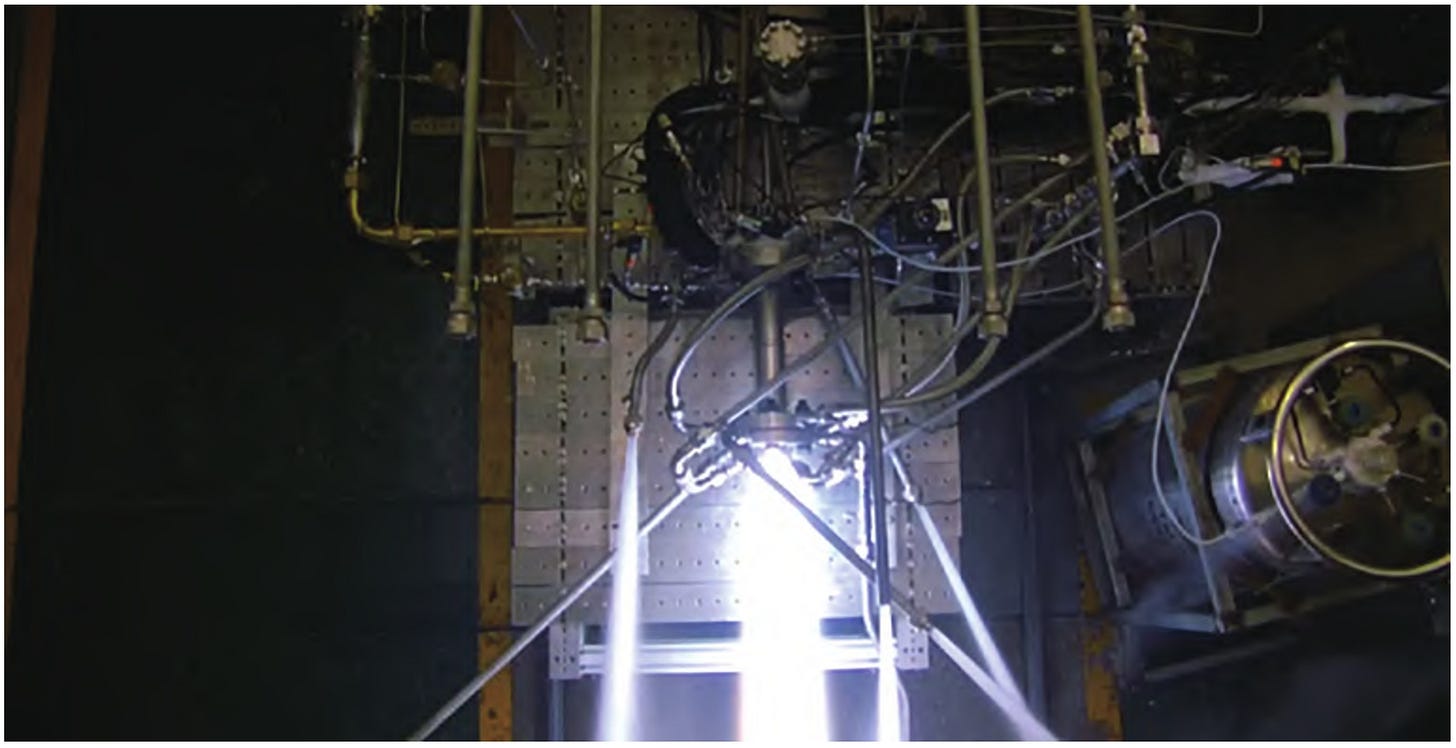China Expands Development Efforts for Full-Flow Rocket Engines
Several high-power engines could power massive reusable launch vehicles.

China’s space sector has two full-flow staged-combustion engines conducting test firings, with three more planned to be developed.
Having sneakily revealed a test firing two weeks ago, LandSpace shared some further details on the development of the BF-20 (蓝焱-20) liquid methane and liquid oxygen burning full-flow staged-combustion engine. LandSpace says that they have fired up BF-20 over thirty times so far during its development, reaching a current peak tested thrust of 110 tons, half of the aimed 220 tons (near the performance of SpaceX’s flown ‘Raptor 2’). Additionally, some footage of a recent firing was shared as well, via CCTV13.
Development milestones have been closely guarded at LandSpace, with research work beginning on BF-20 toward the end of 2021. But it is expected to play a key role in the company’s post-2030s launch offerings, powering a 10-meter-diameter fully reusable launch vehicle, nicknamed ‘Zhuque-4’.
LandSpace Founder and Chief Executive Officer Zhang Changwu (张昌武) is a firm believer in full-flow staged-combustion engines being a key technology to bring down launch costs, expecting a proliferation of engines using the cycle to power many reusable launch solutions.
Meanwhile, a newspaper report quietly revealed that Space Pioneer is also working on a similar engine. According to a Jiaozuo Daily (焦作日报) report released on September 17th regarding a meeting between the Jiaozuo municipal Party Committee and a delegation from Space Pioneer (at a trade and investment event), where they discussed accelerating development of a full-flow staged-combustion engine. Relevant parts of the news report stated:
“The two sides had in-depth exchanges on accelerating the construction of the full-flow engine China headquarters base project and deepening the coordinated development of the space industry chain.” — “Following multiple rounds of in-depth discussions and the signing of a strategic cooperation agreement, the newly signed [Space Pioneer] Full-Flow Engine China Headquarters Base Project, with a total investment of 4 billion yuan1, will undoubtedly serve as a powerful engine for Jiaozuo to build an space industry cluster and accelerate the development of new productive forces.”
If there are any problems with this translation please reach out and correct me.
It was also said that the city of Jiaozuo (焦作市)2 would explore providing land, policy support, and some funding to the development effort. The development project is expected to draw capabilities of existing local enterprises, including some state-owned ones.
Space Pioneer has revealed no details on the full-flow staged-combustion engine. Although the company is looking to build a test stand capable of withstanding 300 tons of thrust, supplied with rocket-grade kerosene and liquid oxygen. That level of thrust would have the engine surpass SpaceX’s in-development ‘Raptor 3’ while being the first with its propellant choice.
While a surprising development considering the current status of Space Pioneer, having recently completed a redone first-stage static fire, it was somewhat expected for the Kang Yonglai (康永来) headed company, as he was LandSpace’s Chief of Technology until the end of 2018, likely also aligning with Zhang’s vision.
Alongside the commercial sector, state-owned enterprises are pursuing massive reusable launch vehicles, like the Long March 9, and developing necessary engines. The Academy of Aerospace Liquid Propulsion Technology (航天推进技术研究院; 航天六院) is currently testing the YF-215 liquid methane and liquid oxygen burning full-flow staged-combustion engine, set to generate 200 tons of thrust.
Initial research into the engine is stated to have begun in 2010, with designs of the engine solidified around 2022. Through 2023, various sub-scale tests were completed to verify igniters and turbopumps. Sub-scale tests are said to have been successfully concluded in mid-2024, having demonstrated key technologies for a full-size engine. In recent months, a partial test of a complete test engine was reported3 to have been completed. It is rumored that a full-system test of the YF-215 may take place before the end of the year.

Other efforts to develop full-flow staged-combustion engines are currently in their very early days with new launch startups Welight (微光航行) and Arktech (星梭科技).
So which full-flow staged-combustion engine will fly first? With Space Pioneer, Welight, and Arktech’s engines yet to be made and the BF-20 performing half-thrust tests, it will likely be the YF-215. ‘Zhuque-4’ is not currently LandSpace’s development priority, while the China Academy of Launch Vehicle Technology’s Long March 9 has been gradually passing through development in recent years, for a debut flight set around 2033.
With a lack of direct word or imagery from the Academy of Aerospace Liquid Propulsion Technology it would appear that LandSpace is ahead, but it is unsurprising that a commercial enterprise is sharing images sooner than a state-owned enterprise. Development hype of the high-power engine can be used to give investors confidence and possibly greater financing for the commercial developer. In contrast, state-owned enterprises can develop their hardware behind closed doors and build to targeted specifications without needing to showcase it for venture capital investor appeal.
About 562 million United States Dollars as of September 19th.
A city of 3.59 million people, with an economy of 31.5 billion United States Dollars, in northern Henan (河南) province.
At the 9th China Aerospace Power Joint Conference (第九届中国空天动力联合大会) in August.


